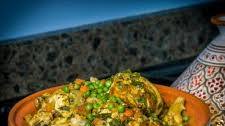The Delightful Tradition of Moroccan Couscous
When it comes to Moroccan cuisine, one dish stands out as a symbol of tradition, community, and flavourful delight—couscous. This ancient staple has been a cornerstone of Moroccan cooking for centuries, bringing families and friends together around a communal table to share in its savoury goodness.
A Culinary Heritage
Couscous holds a special place in Moroccan culture, with its origins dating back to Berber tribes who inhabited North Africa. This fine grain made from semolina wheat is meticulously steamed and fluffed to perfection, creating a light and fluffy texture that serves as the perfect base for an array of vibrant ingredients.
The Art of Preparation
Preparing traditional Moroccan couscous is an art form that requires patience and skill. The couscous itself is steamed in a special pot called a “cuscera,” allowing the grains to absorb the aromatic steam from the simmering stew below. This process results in couscous that is not only tender but infused with the rich flavours of the accompanying ingredients.
A Symphony of Flavours
What sets Moroccan couscous apart is its diverse range of ingredients that come together harmoniously to create a symphony of flavours. From tender chunks of lamb or chicken to sweet raisins, hearty chickpeas, and an array of fragrant spices like cumin, cinnamon, and saffron—each component adds depth and complexity to this beloved dish.
A Social Affair
Sharing a steaming plate of couscous is more than just a meal; it’s a social affair that fosters connection and community. In Moroccan households, Fridays are often reserved for preparing couscous—a tradition that brings families together to bond over this cherished dish.
The Perfect Harmony
Whether enjoyed at home with loved ones or savoured in a bustling souk in Marrakech, traditional Moroccan couscous embodies the essence of Morocco’s culinary heritage. Its blend of textures, aromas, and flavours creates a sensory experience that lingers long after the last bite.
Exploring Traditional Moroccan Couscous: Ingredients, Preparation, and Cultural Significance
- What is traditional Moroccan couscous made from?
- How is Moroccan couscous traditionally prepared?
- What are the main ingredients used in a traditional Moroccan couscous dish?
- Is Moroccan couscous gluten-free?
- What spices are commonly used in Moroccan couscous?
- How is couscous typically served in Morocco?
- Can I make traditional Moroccan couscous with vegetables only?
- What is the significance of serving couscous on Fridays in Morocco?
What is traditional Moroccan couscous made from?
Traditional Moroccan couscous is made from semolina wheat, a finely ground durum wheat that forms the base of this iconic dish. The semolina is steamed and fluffed to create the light, fluffy texture that couscous is known for. This versatile grain serves as a canvas for a myriad of ingredients, including tender meats, vegetables, chickpeas, and an array of aromatic spices that infuse each bite with a burst of flavour. The careful preparation and combination of these elements result in a dish that embodies the rich culinary heritage and vibrant flavours of Morocco.
How is Moroccan couscous traditionally prepared?
In Moroccan culinary tradition, preparing couscous is a meticulous process that involves steaming the fine semolina grains in a special pot known as a “cuscera.” This traditional method allows the couscous to absorb the aromatic steam rising from the simmering stew below, infusing it with rich flavours. The result is tender, fluffy couscous that serves as the perfect canvas for an array of vibrant ingredients. From slow-cooked meats and vegetables to a medley of fragrant spices, each component contributes to the complexity and depth of flavour that defines authentic Moroccan couscous. This careful preparation not only ensures a delicious meal but also honours the cultural heritage and communal spirit that surrounds this beloved dish.
What are the main ingredients used in a traditional Moroccan couscous dish?
In a traditional Moroccan couscous dish, the main ingredients that come together to create its distinctive and rich flavour profile include tender chunks of lamb or chicken, sweet and plump raisins, hearty chickpeas, and a fragrant blend of spices such as cumin, cinnamon, and saffron. These key components harmonise to form a symphony of textures and aromas that define the essence of Moroccan cuisine. The careful combination of these ingredients reflects the culinary heritage of Morocco and showcases the country’s diverse cultural influences in each savoury bite of this beloved dish.
Is Moroccan couscous gluten-free?
For those wondering about the gluten content of traditional Moroccan couscous, it’s important to note that authentic couscous is made from semolina wheat, which contains gluten. Therefore, traditional Moroccan couscous is not gluten-free. However, there are gluten-free alternatives available, such as couscous made from corn or rice. It’s always advisable for individuals with gluten sensitivities or allergies to check the ingredients and preparation methods when enjoying Moroccan cuisine to ensure a safe and enjoyable dining experience.
What spices are commonly used in Moroccan couscous?
In traditional Moroccan couscous, a medley of aromatic spices plays a pivotal role in creating its distinctive and rich flavour profile. Commonly used spices include cumin, coriander, cinnamon, turmeric, ginger, and paprika. These spices not only add depth and warmth to the dish but also infuse it with a tantalising blend of sweet, savoury, and earthy notes that are characteristic of Moroccan cuisine. The careful balance of these spices is what elevates Moroccan couscous from a simple grain dish to a culinary masterpiece that delights the senses and captures the essence of Morocco’s vibrant culinary heritage.
How is couscous typically served in Morocco?
In Morocco, couscous is typically served as a central dish during festive occasions, family gatherings, and special celebrations. The preparation and presentation of couscous are considered an art form, with the fluffy semolina grains often topped with a hearty stew of meat (such as lamb or chicken), vegetables (like carrots, zucchini, and chickpeas), and a medley of aromatic spices. The dish is traditionally served on a large communal platter, encouraging diners to gather around and share in the savoury goodness together. This communal dining experience reflects the importance of hospitality and togetherness in Moroccan culture, making every meal featuring couscous a memorable and enriching experience.
Can I make traditional Moroccan couscous with vegetables only?
Exploring the culinary landscape of traditional Moroccan couscous often leads to the question: Can I make this iconic dish with vegetables alone? While the essence of Moroccan couscous typically includes a medley of meat, vegetables, and aromatic spices, a vegetable-only version can indeed be crafted to suit vegetarian or vegan preferences. By incorporating a colourful array of seasonal vegetables such as carrots, zucchini, bell peppers, and chickpeas, along with a blend of traditional Moroccan spices like cumin and paprika, one can create a flavourful and satisfying rendition of this beloved dish that celebrates the vibrant essence of Moroccan cuisine.
What is the significance of serving couscous on Fridays in Morocco?
In Morocco, the tradition of serving couscous on Fridays holds deep cultural and social significance. Fridays are considered a day of communal prayer and gathering in the Islamic faith, making it a special time for families to come together and share a meal. By preparing couscous on this sacred day, Moroccans not only honour their culinary heritage but also strengthen bonds with loved ones through the act of sharing food. The ritual of serving couscous on Fridays symbolises unity, hospitality, and the importance of family connections in Moroccan society.




